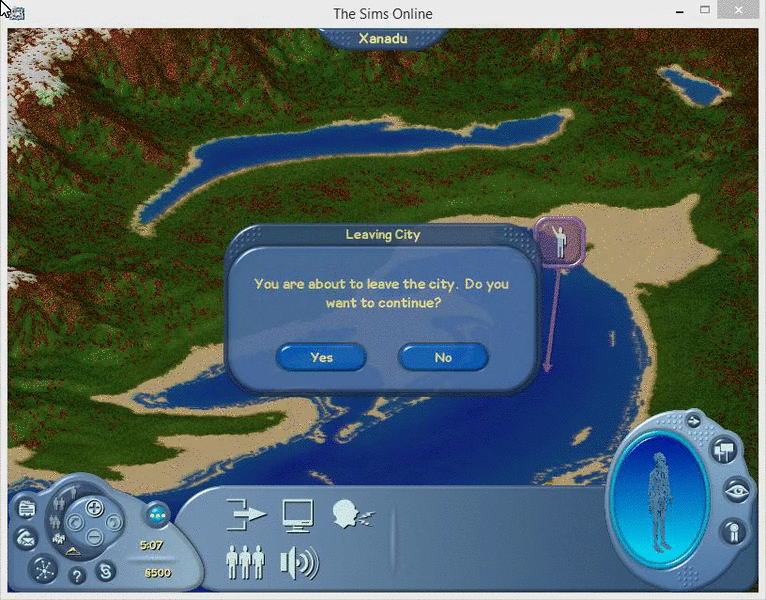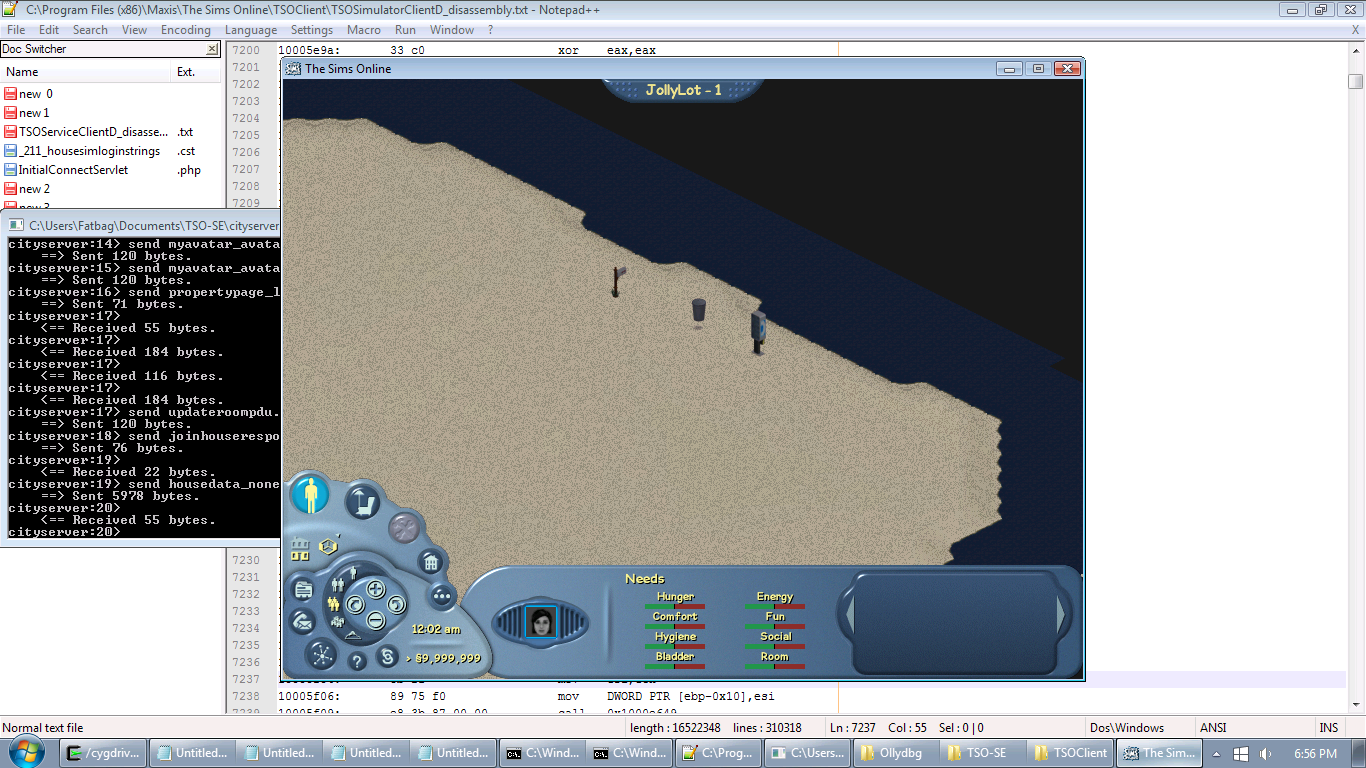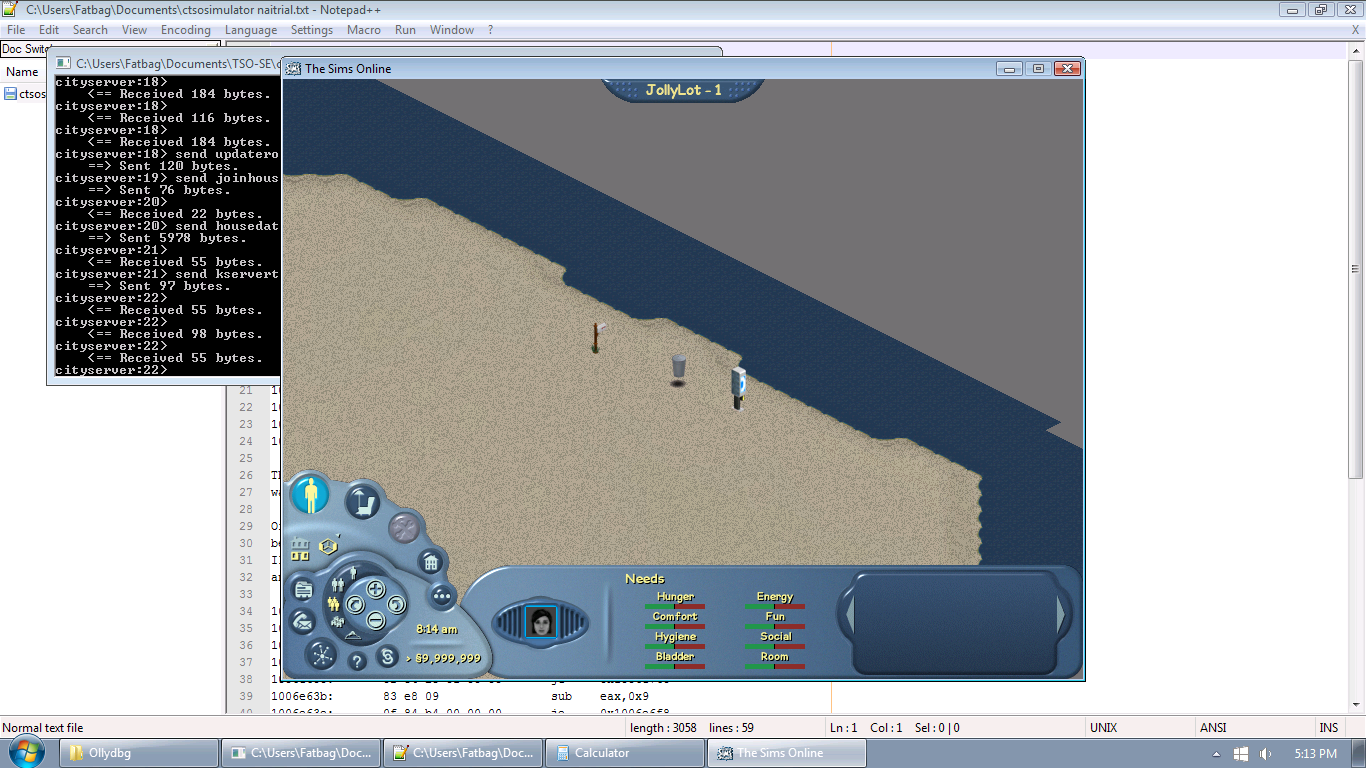No final decisions just yet! We're still needing to do a lot of other content, so not yet.Are you going to make an automated server at some point?
You are using an out of date browser. It may not display this or other websites correctly.
You should upgrade or use an alternative browser.
You should upgrade or use an alternative browser.
TSO-SE Discussion Thread
- Thread starter Blayer98
- Start date
The skills panel is from Play Test, I've seen it myself in NoNetworkI tried looking for any screenshots of the Sim Pages and this is all i could find so far. first one if from the manual but the skills look like some kind of beta version.
View attachment 662 View attachment 659 View attachment 660 View attachment 661
Nice try but not really necessary when we have that : http://niotso.org/manuals/TheSimsOnline_manual.pdf.I tried looking for any screenshots of the Sim Pages and this is all i could find so far. first one if from the manual but the skills look like some kind of beta version.
View attachment 662 View attachment 659 View attachment 660 View attachment 661
Okay, so I decided to give Pre-Alpha's map view and CAS a shot, since we haven't done GetCharBlobByID. (LoadAvatarByID)
I found the request packet in log.dat, and it's bundled with other Requests, such as GetRoomateInfoByLotID and GetBookmarks.
Below is the packet for GetCharBlobByID, and it's the request version. (We haven't ever made a GetCharBlobByID, only ones that crash the game )
)
I will be labeling it and I'll post it here once it is. 
I found the request packet in log.dat, and it's bundled with other Requests, such as GetRoomateInfoByLotID and GetBookmarks.
Below is the packet for GetCharBlobByID, and it's the request version. (We haven't ever made a GetCharBlobByID, only ones that crash the game
Code:
00 82 00 00 00 4D 80 00 00 00 80 00 00 00 00 00 00 00 00 39 12 51 94 E5 21 3B F8 2D 4E 5B B7 3F AB 00 00 05 39 3A 43 3D 64 65 6C 69 46 69 4D 5C 73 6F 72 50 5C 6D 61 72 67 6C 69 46 20 28 20 73 65 29 36 38 78 6D 6F 43 5C 20 6E 6F 6Dfrancot514
Well-Known Member
I like panel skills bars, but not colors, why you say is from beta?? beta before pre alpha???I tried looking for any screenshots of the Sim Pages and this is all i could find so far. first one if from the manual but the skills look like some kind of beta version.
Good work so far..Okay, so I decided to give Pre-Alpha's map view and CAS a shot, since we haven't done GetCharBlobByID. (LoadAvatarByID)
I like panel skills bars, but not colors, why you say is from beta?? beta before pre alpha???
Good work so far..
Play Test had that look for the skills panel, and Charter Edition doesn't have it. (I'm not sure about Pre-Alpha since we need GetCharBlobByID.)
Pre-Alpha was BEFORE Play Test, by the way
GOOD NEWS! We've finally got a packet that now works and that it can get us into the map view from CAS. The Free Will button works too, but the UI for the Free Will isn't there yet, and we've also got a packet that can now get us into the lot with WORKING objects!  (We still can't get an Avatar in the lot though, which is annoying...)
(We still can't get an Avatar in the lot though, which is annoying...)
Keep in mind that the Avatar doesn't save because we'd need the AvatarDataServlet to update automatically, which doesn't work since we don't have a DB.

Keep in mind that the Avatar doesn't save because we'd need the AvatarDataServlet to update automatically, which doesn't work since we don't have a DB.

yeah, it's like that in the Charter Edition's NoNetwork mode too, the lot is simply an exact duplicate of defaulthouse.dat from Charter Edition.Waaah?! It's soo beautiful! always a pleasant surprise to see progress on this project. and lol, is that trash can floating?
francot514
Well-Known Member
Very good work Fatbag and Blayer98GOOD NEWS! We've finally got a packet that now works and that it can get us into the map view from CAS
Okay, it turns out that the lot terrain type is specified in the "String ID" field (as we're currently calling it on the wiki) in cTSONetMessageStandard. Here is a screenshot:

The terrain types are:
0 and 5 should not appear in normal lots.
These terrain types cause the game to generate the following commands:
In fact, there are two additional terrain commands which the server cannot communicate to the client. They are:
The Launch US version of TSO in -NoNetwork Mode generates the terrain command 0x9F (kCmdTerrainStyleSand) at TSOClient_base+0x14406 (with the instruction "push 0x9f"). By modifying this instruction, you can change the lot to any terrain type including the LineRender types.
Here are all of the terrain types in TSO (screenshots taken from Launch US -NoNetwork mode):
http://niotso.org/files/terrain_types/
With TSO-SE, click to enter the city. To get into the map view, send:
hostonlinepdu.dat
loadavatarbyid_dbf301a9.dat
Afterwards, to make the lot appear on the map, send:
currentcity_city_reservedlotinfo.dat
Then, click to enter the lot, and then send:
updateroompdu.dat
joinhouseresponse.dat
housedata_nonetworkhouse_sand.dat

The terrain types are:
Code:
0: base
1: grass
2: sand
3: rock
4: snow
5: water0 and 5 should not appear in normal lots.
These terrain types cause the game to generate the following commands:
Code:
0x9D: kCmdTerrainStyleBase
0x9E: kCmdTerrainStyleGrass
0x9F: kCmdTerrainStyleSand
0xA0: kCmdTerrainStyleRock
0xA1: kCmdTerrainStyleSnow
0xA2: kCmdTerrainStyleWaterIn fact, there are two additional terrain commands which the server cannot communicate to the client. They are:
Code:
0xA3: kCmdTerrainStyleLineRender1
0xA4: kCmdTerrainStyleLineRender2The Launch US version of TSO in -NoNetwork Mode generates the terrain command 0x9F (kCmdTerrainStyleSand) at TSOClient_base+0x14406 (with the instruction "push 0x9f"). By modifying this instruction, you can change the lot to any terrain type including the LineRender types.
Here are all of the terrain types in TSO (screenshots taken from Launch US -NoNetwork mode):
http://niotso.org/files/terrain_types/
With TSO-SE, click to enter the city. To get into the map view, send:
hostonlinepdu.dat
loadavatarbyid_dbf301a9.dat
Afterwards, to make the lot appear on the map, send:
currentcity_city_reservedlotinfo.dat
Then, click to enter the lot, and then send:
updateroompdu.dat
joinhouseresponse.dat
housedata_nonetworkhouse_sand.dat
Last edited:
They probably had that in just in case there was a water tile which a lot could be created on.I love how they made a preset for water, though they probably could have done a little better than solid blue.
LetsRaceBwoi
Well-Known Member
Because physics.They probably had that in just in case there was a water tile which a lot could be created on.
Okay, I've been talking with Fatbag, here's our conversation, it's about how the Avatar spawns, but most of it is about the NPC spawning 
Hmm
We might also want to learn how visitors arrive on the lot in The Sims 1.
LOLWTF
Visitors arrive via the *Portal - Pedestrian debug object, did you forget? XD
the same happens with TSO, but it's NPCs who use them now.
"Debug object" isn't really the right word. It's more like internal object, etc.
There IS one on the lot we specified, keep in mind.
Yeah, -NoNetwork mode displays it, and online mode hides it.
Here's the information about spawning an avatar, and how interactions and routing works and a picture showing the Gonzo Debug Window in Pre-Alpha, which shows that the Command had printed onto the window: "NewObjectCreated" which is probably related to kServerCreateObjectEvent, and kClientCreateObjectEvent in TSO N&I.

Also appointment locations are defined as 218XXX (XXX being the coordinate of the location)
the 218 never changes.
So, we need to call Server or ClientCreateObjectEvent.
Also, DAT MAID'S DEATH STARE THO!
Hmm
We might also want to learn how visitors arrive on the lot in The Sims 1.
LOLWTF
Visitors arrive via the *Portal - Pedestrian debug object, did you forget? XD
the same happens with TSO, but it's NPCs who use them now.
"Debug object" isn't really the right word. It's more like internal object, etc.
There IS one on the lot we specified, keep in mind.
Yeah, -NoNetwork mode displays it, and online mode hides it.
Here's the information about spawning an avatar, and how interactions and routing works and a picture showing the Gonzo Debug Window in Pre-Alpha, which shows that the Command had printed onto the window: "NewObjectCreated" which is probably related to kServerCreateObjectEvent, and kClientCreateObjectEvent in TSO N&I.

Also appointment locations are defined as 218XXX (XXX being the coordinate of the location)
the 218 never changes.
So, we need to call Server or ClientCreateObjectEvent.
Also, DAT MAID'S DEATH STARE THO!
If you need any information about how the sims online uses its objects, or the VM in general I'd be happy to help! I'm really ecstatic about this - though I suspected the event system's existance (and modelled our own multiplayer over it) I never considered that it would be cracked so quickly. Very nice work.
I don't feel like typing up a long post, so, here are our notes:
By placing a breakpoint on the ClientIdle function, you can see that when the house is first loaded, both current_tick and simulate_until are set to 0.
If you send a kServerTickConfirmationMsg cTSONetMessageStandard, it turns out that 0x1006e663 is reached, and subsequently, 0x1006f33a is reached with eax corresponding to the value of the "String ID" field (gosh, we need to rename that). Since there are 5 real world seconds per game minute and 25 SimAntics ticks per real world second, I set this value to 0xaf for 175 ticks or 7 real world seconds, and sure enough, the game time changed from 12:01 to 12:02.
So kServerTickConfirmationMsg updates the value of simulate_until. But is this seriously all we need to do: send the packet several times per second and the simulation works? What about the server "confirming" that the client is in sync etc.? How does the client receive actions from other players? And what do we need to do to ensure that the simulation is smooth for the player?
It seems that, to ensure that the client is still in sync with the server, the client will periodically call cTSOSimulator::AssembleAndSendChecksum and cTSOSimulator::AssembleAndSendChecksync, at least when the server asks the client to do so; but so far this hasn't happened yet.
It seems that the client should receive player actions from another packet, and that the server should send these packets before sending the kServerTickConfirmationMsg to the client for the tick when those actions are scheduled to occur.
It turns out that, if you set the simulate_until value to a really high value (many game hours in the future), to catch up to the current time, the game does not simulate as fast as it can, but instead, it gradually increases the speed of the simulation and then gradually decreases the speed when it begins approaching the current time.
As for whether or not the game buffers the kServerTickConfirmationMsg packets it receives and only responds to them after a certain scheduled time in the future (e.g. an 0.5 second latency would protect against dropouts up to 0.5 seconds long), I'm not sure yet.
Here is the packet:
http://niotso.org/files/kservertickconfirmationmsg.dat
and a screenshot:

Code:
prealpha -> naitrial
Member functions:
cTSOSimulator::cTSOSimulator: TSOSimulatorClientD_base+0x1cce5 -> TSOSimulatorClientD_base+0x6c9a4
cTSOSimulator::SetSpeed: TSOSimulatorClientD_base+0x1d722 -> TSOSimulatorClientD_base+0x6d387
cTSOSimulator::AssembleAndSendChecksum: TSOSimulatorClientD_base+0x1de93 -> TSOSimulatorClientD_base+0x6dbbf
cTSOSimulator::AssembleAndSendChecksync: TSOSimulatorClientD_base+0x1df41 -> TSOSimulatorClientD_base+0x6dc1c
cTSOSimulator::ScheduleLocalEvent: TSOSimulatorClientD_base+0x1e10a -> ?
cTSOSimulator::LocalPause: TSOSimulatorClientD_base+0x1e26b -> TSOSimulatorClientD_base+0x6de4c
cTSOSimulator::LocalUnpause: TSOSimulatorClientD_base+0x1e35a -> TSOSimulatorClientD_base+0x6debb
cTSOSimulator::ClientIdle: cTSOSimulatorClient_base+0x1ecfc -> TSOSimulatorClientD_base+0x6ec79
cTSOSimulator::HandleEvent: TSOSimulatorClientD_base+0x1f192 -> ?
Member variables:
cTSOSimulator::sim_speed: +0x68 -> ?
cTSOSimulator::tick_number: +0xcc -> 0xd4
cTSOSimulator::is_paused: +0xf4 -> 0x100
cTSOSimulator::simulate_until: +0xfc -> 0x108
Do a regex search for "DWORD PTR \[.*\+0x108\]," in TSOSimulatorClientD.dll,
and the result is:
10067963: 89 83 08 01 00 00 mov DWORD PTR [ebx+0x108],eax
1006ca7b: 89 9e 08 01 00 00 mov DWORD PTR [esi+0x108],ebx <- being set to 0
1006f33a: 89 86 08 01 00 00 mov DWORD PTR [esi+0x108],eax
1009c07c: 89 8e 08 01 00 00 mov DWORD PTR [esi+0x108],ecx
That leaves us with 10067963, 1006f33a, and 1009c07c as potentially the code we
want to reach to increment the simulate_until variable.
Of these three, 1006f33a is perhaps the most interesting (at least in my
opinion) because it appears to retrieve its value from an object that accepts
IID=0x65297976 (kGZIID_cIGZMessage2Standard). The function starts at 0x1006f2ea
and is called by this code:
1006e62a: ff 50 10 call DWORD PTR [eax+0x10]
1006e62d: 6a 01 push 0x1
1006e62f: 2d 03 3d 7c 2c sub eax,0x2c7c3d03
1006e634: 5b pop ebx
1006e635: 0f 84 28 01 00 00 je 0x1006e763
1006e63b: 83 e8 09 sub eax,0x9
1006e63e: 0f 84 b4 00 00 00 je 0x1006e6f8
1006e644: 2d 86 fa dc 11 sub eax,0x11dcfa86
1006e649: 0f 84 90 00 00 00 je 0x1006e6df
1006e64f: 83 e8 0c sub eax,0xc
1006e652: 74 19 je 0x1006e66d
1006e654: 2d 03 ec 15 2d sub eax,0x2d15ec03
1006e659: 0f 85 b5 01 00 00 jne 0x1006e814
1006e65f: 57 push edi
1006e660: 8d 4e dc lea ecx,[esi-0x24]
1006e663: e8 82 0c 00 00 call 0x1006f2ea
0x2c7c3d03 = 0x2C7C3D03 -> ?
0x2c7c3d03+0x9 = 0x2C7C3D0C -> ?
0x2c7c3d03+0x9+0x11dcfa86 = 0x3E593792 -> ?
0x2c7c3d03+0x9+0x11dcfa86+0xc = 0x3E59379E -> ?
0x2c7c3d03+0x9+0x11dcfa86+0xc+0x2d15ec03 = 0x6B6F23A1 -> kServerTickConfirmationMsg (!!!!!)
This is very interesting because the debugging string in naitrial
"TicksPerServerConfirmation" (at TSOSimulatorClientD_base+0x6e311) tells us that
a "server confirmation" provides a number of ticks to the client.By placing a breakpoint on the ClientIdle function, you can see that when the house is first loaded, both current_tick and simulate_until are set to 0.
If you send a kServerTickConfirmationMsg cTSONetMessageStandard, it turns out that 0x1006e663 is reached, and subsequently, 0x1006f33a is reached with eax corresponding to the value of the "String ID" field (gosh, we need to rename that). Since there are 5 real world seconds per game minute and 25 SimAntics ticks per real world second, I set this value to 0xaf for 175 ticks or 7 real world seconds, and sure enough, the game time changed from 12:01 to 12:02.
So kServerTickConfirmationMsg updates the value of simulate_until. But is this seriously all we need to do: send the packet several times per second and the simulation works? What about the server "confirming" that the client is in sync etc.? How does the client receive actions from other players? And what do we need to do to ensure that the simulation is smooth for the player?
It seems that, to ensure that the client is still in sync with the server, the client will periodically call cTSOSimulator::AssembleAndSendChecksum and cTSOSimulator::AssembleAndSendChecksync, at least when the server asks the client to do so; but so far this hasn't happened yet.
It seems that the client should receive player actions from another packet, and that the server should send these packets before sending the kServerTickConfirmationMsg to the client for the tick when those actions are scheduled to occur.
It turns out that, if you set the simulate_until value to a really high value (many game hours in the future), to catch up to the current time, the game does not simulate as fast as it can, but instead, it gradually increases the speed of the simulation and then gradually decreases the speed when it begins approaching the current time.
As for whether or not the game buffers the kServerTickConfirmationMsg packets it receives and only responds to them after a certain scheduled time in the future (e.g. an 0.5 second latency would protect against dropouts up to 0.5 seconds long), I'm not sure yet.
Here is the packet:
http://niotso.org/files/kservertickconfirmationmsg.dat
and a screenshot:






